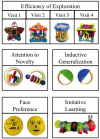The Efficiency of Infants' Exploratory Play Is Related to Longer-Term Cognitive Development
- PMID: 29904360
- PMCID: PMC5991261
- DOI: 10.3389/fpsyg.2018.00635
The Efficiency of Infants' Exploratory Play Is Related to Longer-Term Cognitive Development
Abstract
In this longitudinal study we examined the stability of exploratory play in infancy and its relation to cognitive development in early childhood. We assessed infants' (N = 130, mean age at enrollment = 12.02 months, SD = 3.5 months; range: 5-19 months) exploratory play four times over 9 months. Exploratory play was indexed by infants' attention to novelty, inductive generalizations, efficiency of exploration, face preferences, and imitative learning. We assessed cognitive development at the fourth visit for the full sample, and again at age three for a subset of the sample (n = 38). The only measure that was stable over infancy was the efficiency of exploration. Additionally, infants' efficiency score predicted vocabulary size and distinguished at-risk infants recruited from early intervention sites from those not at risk. Follow-up analyses at age three provided additional evidence for the importance of the efficiency measure: more efficient exploration was correlated with higher IQ scores. These results suggest that the efficiency of infants' exploratory play can be informative about longer-term cognitive development.
Keywords: IQ; cognitive development; exploratory play; infancy; longitudinal design.
Figures




Similar articles
-
Exploring individual differences in infants' looking preferences for impossible events: The Early Multidimensional Curiosity Scale.Front Psychol. 2023 Feb 2;13:1015649. doi: 10.3389/fpsyg.2022.1015649. eCollection 2022. Front Psychol. 2023. PMID: 36817372 Free PMC article.
-
Maternal object naming is less adapted to preterm infants' than to term infants' word mapping.J Child Psychol Psychiatry. 2020 Apr;61(4):447-458. doi: 10.1111/jcpp.13128. Epub 2019 Nov 11. J Child Psychol Psychiatry. 2020. PMID: 31710089
-
Relation of infants' and mothers' pointing to infants' vocabulary measured directly and with parental reports.Infancy. 2023 Nov-Dec;28(6):1007-1029. doi: 10.1111/infa.12558. Epub 2023 Sep 1. Infancy. 2023. PMID: 37655834
-
The developmental origins of naïve psychology in infancy.Adv Child Dev Behav. 2009;37:55-104. doi: 10.1016/s0065-2407(09)03702-1. Adv Child Dev Behav. 2009. PMID: 19673160 Review.
-
The ecology of infants' perceptual-motor exploration.Curr Opin Psychol. 2020 Apr;32:110-114. doi: 10.1016/j.copsyc.2019.06.035. Epub 2019 Jul 26. Curr Opin Psychol. 2020. PMID: 31445428 Review.
Cited by
-
Wild and zoo-housed orangutans differ in how they explore objects.Sci Rep. 2025 Apr 30;15(1):14853. doi: 10.1038/s41598-025-97926-z. Sci Rep. 2025. PMID: 40307296 Free PMC article.
-
Hand preference trajectories as predictors of language outcomes above and beyond SES: Infant patterns explain more variance than toddler patterns at 5 years of age.Infant Child Dev. 2024 May-Jun;33(3):e2468. doi: 10.1002/ICD.2468. Epub 2023 Oct 10. Infant Child Dev. 2024. PMID: 39170910 Free PMC article.
-
A Longitudinal Study of Preterm Infants at 12 and 30 Months: Links Among Object Interactions, Joint Engagement, and Cognitive Development.Infancy. 2025 Mar-Apr;30(2):e70016. doi: 10.1111/infa.70016. Infancy. 2025. PMID: 40159459 Free PMC article.
-
The Infant and Toddler Curiosity Questionnaire: A Validated Caregiver-Report Measure of Curiosity in Children From 5 to 24 Months.Infancy. 2025 Jan-Feb;30(1):e70001. doi: 10.1111/infa.70001. Infancy. 2025. PMID: 39853857 Free PMC article.
-
Processes Underlying the Relation between Cognitive Ability and Curiosity with Academic Performance: A Mediation Analysis for Epistemic Behavior in a Five-Year Longitudinal Study.J Intell. 2022 Apr 13;10(2):23. doi: 10.3390/jintelligence10020023. J Intell. 2022. PMID: 35466236 Free PMC article.
References
-
- American Psychiatric Association (2013). Diagnostic and Statistical Manual of Mental Disorders (DSM-5®). Arlington, VA: American Psychiatric Publications.
-
- Astington J., Jenkins J. (1995). Theory of mind development and social understanding. Cogn. Emot. 9, 151–165. 10.1080/02699939508409006 - DOI
-
- Baumgartner H., Oakes L. (2013). Investigating the relation between infants' manual activity with objects and their perception of dynamic events. Infancy 18, 983–1006. 10.1111/infa.12009 - DOI
LinkOut - more resources
Full Text Sources
Other Literature Sources

